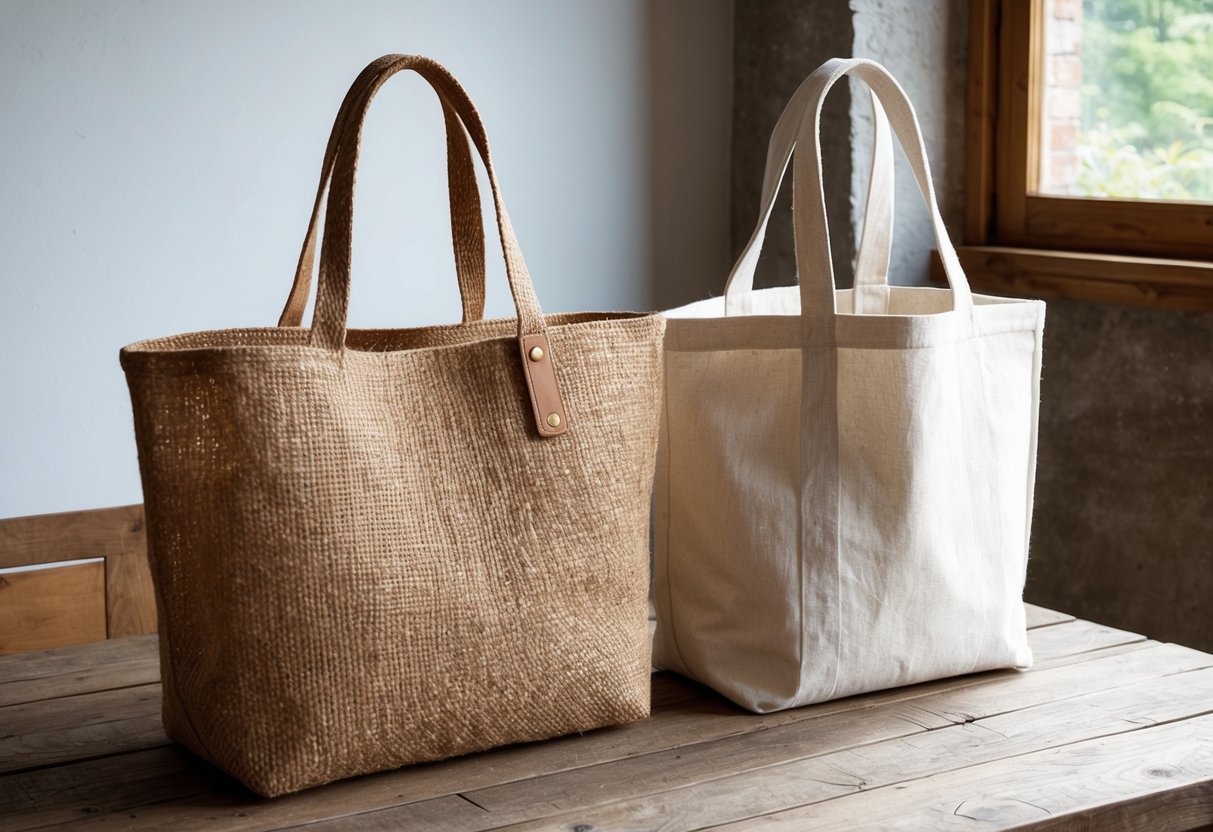Choosing between jute and canvas tote bags can be a critical decision for your daily needs and style preferences. Both materials bring unique qualities to the table.
Jute, with its natural and rustic look, offers a durable and environmentally-friendly option. On the other hand, canvas is known for its smooth texture and versatility, often making it a favorite for branding and casual use.
Table of contents
- Understanding Jute and Canvas Materials
- Assessment of Durability and Strength
- Environmental Impact and Sustainability
- The Cost Factor: Is Jute or Canvas More Cost-Effective?
- Analyzing Aesthetic and Textural Qualities
- Versatility and Functional Differences
- Design Options and Customization
- Care, Maintenance, and Longevity
- Consumer Perspectives on Jute and Canvas Tote Bags
- Frequently Asked Questions
If you’re seeking comfort and durability for everyday carry, canvas tote bags are usually a better choice. Their availability, cost-effectiveness, and potential for water resistance make them quite practical. Plus, they offer an excellent surface for printing designs, adding a personal touch to your style.
Jute bags still hold their own with their biodegradability and sturdy nature. If you’re looking for something sustainable and strong, jute might be your preference.
Understanding Jute and Canvas Materials
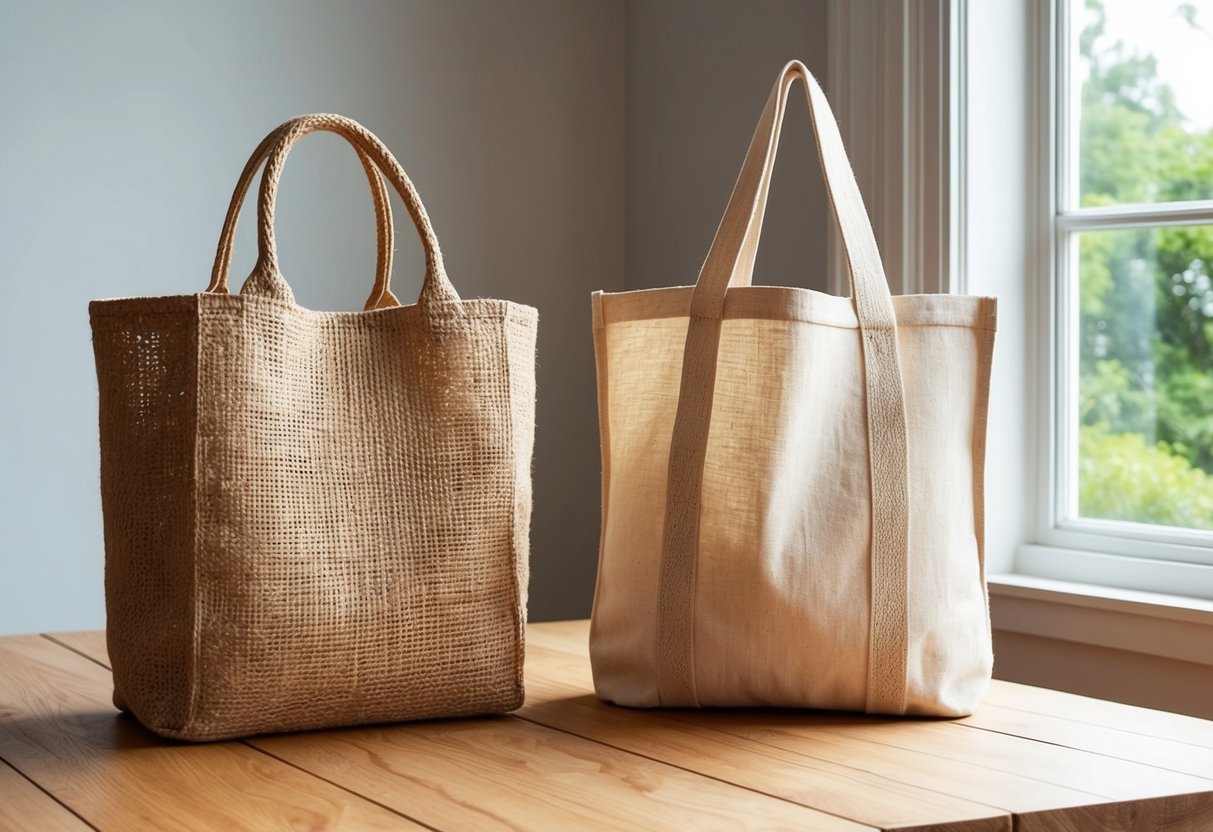
Jute and canvas are popular materials for tote bags, each with distinct qualities that cater to varied needs. While jute is known for its rustic appearance, canvas offers smoothness and versatility.
Origins of Jute and Canvas
Jute is derived from the fibers of the jute plant, primarily grown in tropical regions like India and Bangladesh. This natural fiber is valued for its environmentally friendly properties, as it is biodegradable and renewable.
Canvas, on the other hand, typically comes from cotton or linen and sometimes from hemp. Its origins are more widespread, with its production dating back centuries. Canvas is traditionally used for sails, tents, and art canvases due to its robust nature.
Jute and Canvas: Material Properties
Texture and Strength: Jute has a rough, coarse texture, giving it a natural and rustic look, while canvas has a smoother, softer feel. This makes canvas more comfortable for daily use.
Tensile Strength and Durability: Both materials are durable, but canvas is often considered stronger due to its higher tensile strength and weave. This strength makes canvas able to carry heavier items without tearing.
Water Resistance: Canvas can be treated to become water-resistant, making it more suitable for various weather conditions. Jute, however, lacks this feature, offering a different kind of appeal through its more natural feel.
Assessment of Durability and Strength

Assessing the durability and strength of tote bags made from jute and canvas involves examining their capacity to withstand wear and tear. Canvas is renowned for its sturdiness, while jute offers a unique blend of tensile strength and eco-friendliness.
Tensile Strength Comparisons
Canvas is celebrated for its high tensile strength, which makes it capable of enduring significant loads without tearing. This quality makes it a reliable choice for those needing a tote bag that won’t easily give way under pressure.
Jute, on the other hand, offers considerable strength as well. Its fibers are known for remarkable tensile strength, able to support substantial weight without compromising their structure. Even though jute may not match canvas in all conditions, its strength allows it to handle many everyday tasks effectively.
Durability for Everyday Use
For everyday use, canvas shines due to its resilience. It is specifically known for its ability to resist wear and tear. You can expect it to hold up against regular activities, such as carrying groceries or books, without noticeable deterioration.
Jute’s durability is significant but in a different way. It’s perfect for less rugged environments. While it can manage regular use, the texture may wear over time if subjected to rough conditions consistently. Its durability is best appreciated when used under moderate conditions, ensuring sustainability over many uses.
Environmental Impact and Sustainability
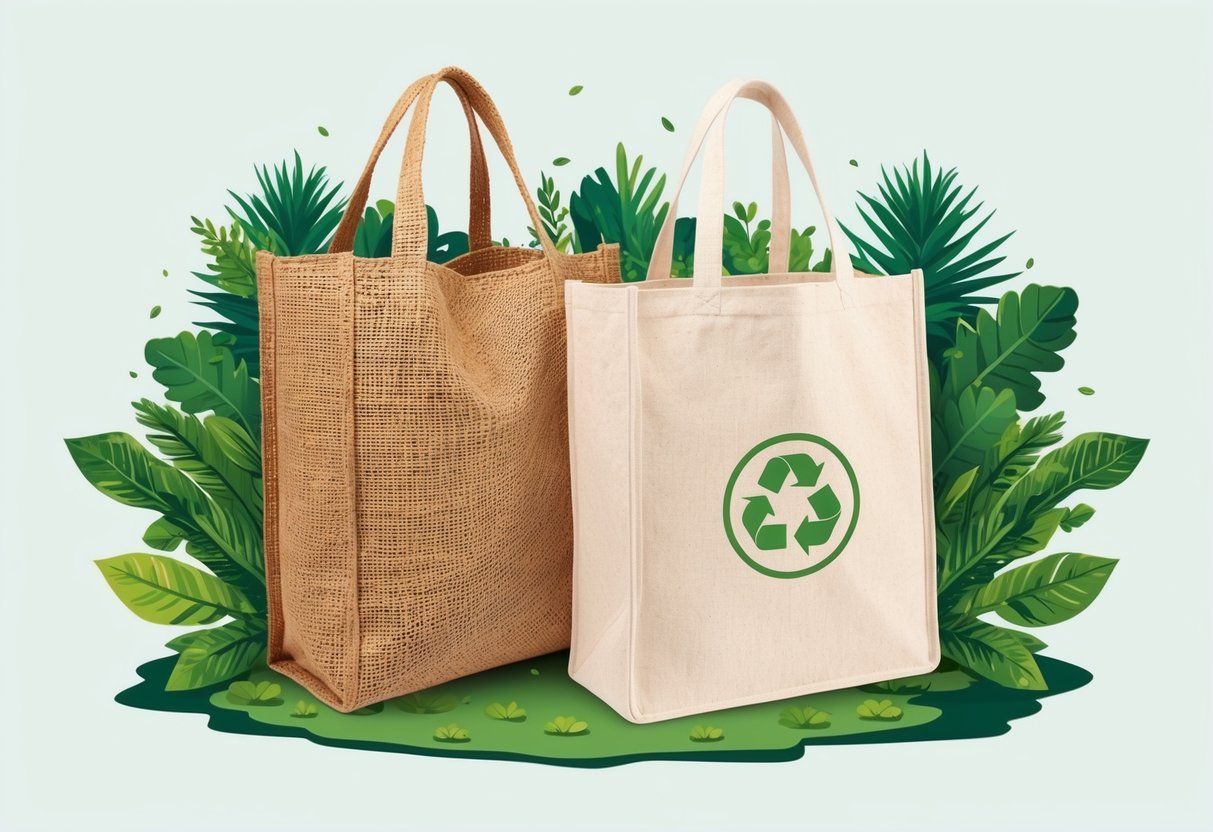
When choosing between jute and canvas tote bags, considering their environmental impact and sustainability is important. Both materials offer eco-friendly alternatives to single-use plastics, but they differ in their biodegradation processes and contributions to sustainable practices.
Biodegradation Process of Jute and Canvas
Jute bags are biodegradable and can break down naturally over time. This makes them an excellent sustainable choice, as they return to the earth without leaving harmful residues. Jute decomposes quickly, usually within a few months, depending on environmental conditions.
Canvas, typically made from cotton, is also biodegradable but may take longer to decompose than jute. The biodegradation rate of canvas relies on how it is processed and used. Although both materials are more eco-friendly compared to plastics, jute has a noticeable advantage due to its faster breakdown.
Contributions to Eco-Friendly Practices
Jute bags are considered a sustainable alternative due to their renewable nature. The jute plant is grown without excessive pesticides and can be harvested annually, making it a sustainable choice. Choosing jute helps reduce reliance on single-use plastics and lowers the environmental impact.
Canvas bags are durable and long-lasting, which promotes reuse. They provide a strong alternative to plastics, minimizing waste over time. While both jute and canvas contribute to eco-friendly practices, the choice depends on your priorities, whether it’s faster biodegradability or extended durability.
The Cost Factor: Is Jute or Canvas More Cost-Effective?

When considering jute and canvas tote bags, cost-effectiveness depends on the price of raw materials and production. Jute bags are typically cheaper due to the lower cost of raw jute compared to canvas. However, factors such as durability and long-term use also play a critical role in determining value.
Pricing Analysis of Tote Bags
Jute tote bags usually cost less upfront. Jute is an affordable material as it is easy to grow and requires minimal processing. This makes jute bags attractive if initial cost savings are your priority.
On the other hand, canvas bags tend to have a slightly higher price point. The canvas is more versatile and offers various customization options, which can add to the cost. While they might require a bigger investment initially, they can offer better longevity if durability is a concern.
Decision-making on cost should also consider how often you plan to use the tote. Jute bags are cost-effective for lightweight, occasional use. Meanwhile, canvas bags might be more practical and an economical choice over time if you need something robust for regular or heavy use.
Analyzing Aesthetic and Textural Qualities
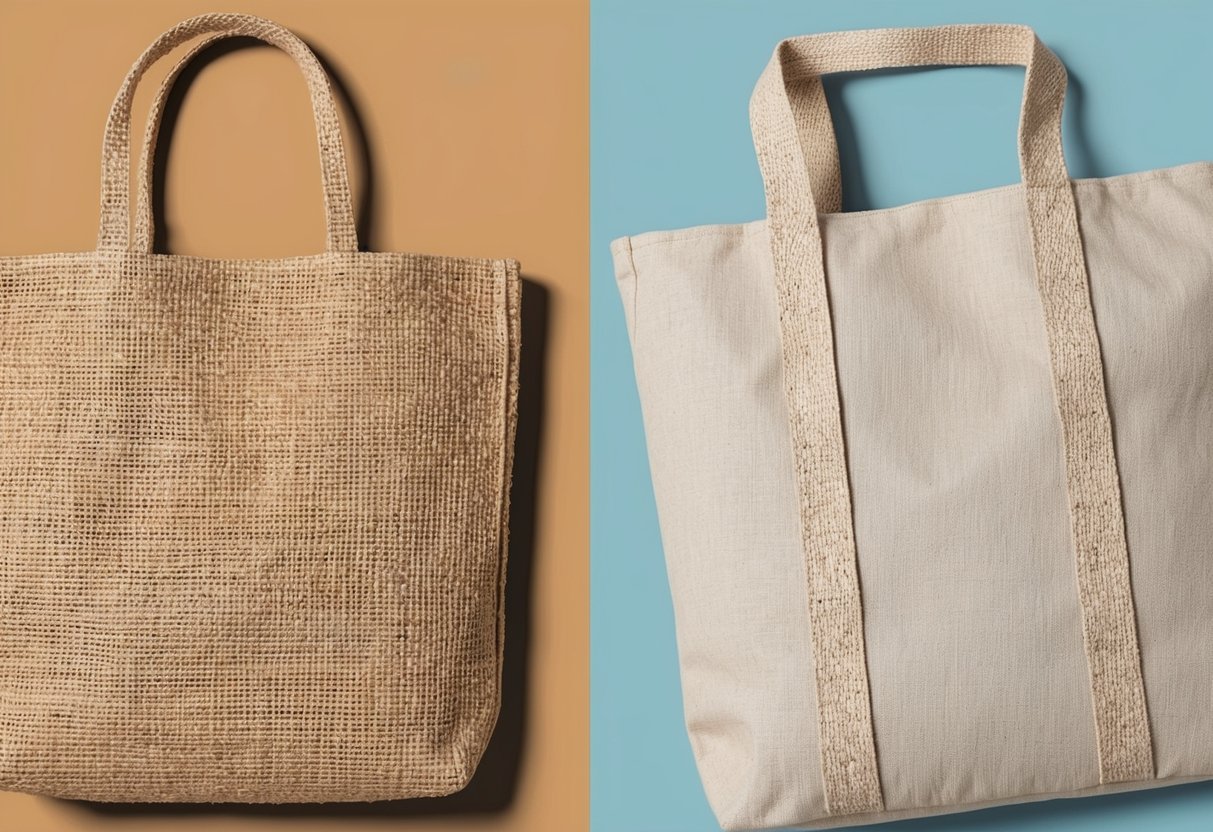
Exploring jute and canvas tote bags, you’ll notice distinct differences in appearance and texture. These qualities are significant for expressing personal style and ensure comfort in daily use.
Visual Appeal and Personal Style
Jute tote bags often have a rustic aesthetic due to their natural, earthy tones. This makes them ideal for those who appreciate a more organic look.
Canvas bags, on the other hand, offer more options in terms of color and design. They are often found in a variety of patterns, allowing you to express your personal style more diversely.
Both materials can complement different outfits, but it’s crucial to choose one that aligns with your personality and fashion sense.
Texture and Feel: From Burlap to Cotton Blends
Jute bags are known for their coarse texture, similar to burlap. This gives them a sturdy feel that can withstand heavy use although it might not be as gentle on your hands.
Canvas tote bags generally have a softer texture. Made from materials like cotton blends, this softness makes them comfortable to touch and carry for long periods.
The choice often depends on your preference for either the rugged feel of jute or the smoother touch of canvas. Both have unique tactile experiences that can influence your decision.
Versatility and Functional Differences

When choosing a tote bag, both jute and canvas come with distinct benefits. Canvas is known for its broad range of uses and practicality in different weather conditions, while jute is appreciated for its natural appeal and eco-friendliness.
Jute vs. Canvas for Everyday Uses
Canvas bags are ideal for daily tasks like shopping, commuting, and running errands. Their smooth texture and sturdy material make them easy to carry around.
You can also find canvas bags in a variety of styles and colors, allowing for easy customization. This makes them perfect for personal use or as a branding tool for businesses.
Jute bags, on the other hand, have a rustic look. They are slightly more rigid, which can limit their versatility. Environmentally conscious users often prefer jute for its biodegradable and sustainable properties, although it is less suited for carrying heavy or sharp items over long distances.
Outdoor Applications and Weather Resistance
Canvas excels in outdoor settings, especially when treated for water resistance. It’s an excellent choice for activities like hiking, camping, or travel, thanks to its durability and ability to withstand different weather conditions.
Jute bags are less resistant to weather impacts. Their coarser texture is not water-resistant, so they can’t hold up as well under rain or in wet environments.
If you plan to use your tote bag for outdoor adventures or need weather protection, canvas is your go-to option. Its ability to be waterproofed adds to its functionality for a wide range of outdoor applications. Jute, being more sensitive to moisture, is best reserved for lighter, indoor uses.
Design Options and Customization
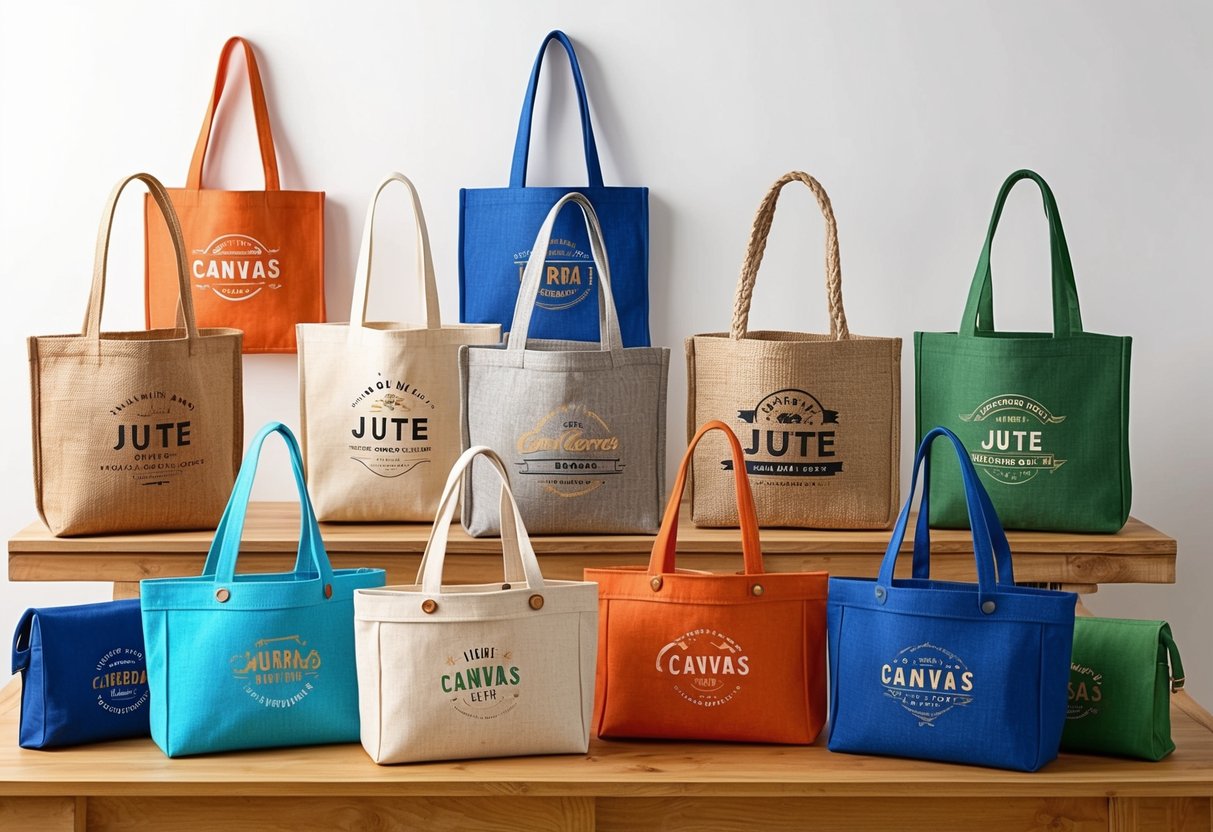
When choosing between jute and canvas tote bags, the design and customization options can greatly influence your decision. Both materials offer unique opportunities for creativity, whether you’re considering artistic expression for personal use or creating something memorable for business purposes.
Creativity in Tote Bag Design
Canvas bags provide a broad canvas—literally—for creative designs. Canvas is smooth and easy to print on, making it ideal for detailed graphics and vibrant colors. You can incorporate patterns and artwork, and it supports a range of printing techniques like screen printing or digital printing.
Jute, on the other hand, adds a rustic look that can be appealing for earthy, organic designs. Although it is not as smooth as canvas, you can still use print and embellishments like embroidery or sewn-on patches. Jute’s natural texture can enhance certain artistic styles, giving a unique edge.
If you’re into DIY projects, both jute and canvas can be decorated at home using fabric paints and markers. This makes designing tote bags a fun and creative activity for all ages.
Personalization for Brands and Consumers
Canvas tote bags are a favorite for companies looking to expand their brand’s reach. The fabric’s accommodating nature allows you to imprint logos and slogans. Due to this, these bags become effective marketing tools, as they are often used in daily life, spreading brand exposure.
For personal use, you can bring your personality to canvas bags with customized designs. These designs can carry personal significance, such as having your name, initials, or favorite motifs printed.
Jute bags also offer branding opportunities, especially for businesses that emphasize sustainability. You can showcase eco-conscious practices through simple yet stylish designs. These designs highlight the jute’s natural appeal.
Both materials offer excellent avenues for personalization tailored to personal style preferences and branding needs.
Care, Maintenance, and Longevity

Jute and canvas tote bags each have specific care practices to ensure they last a long time. Proper cleaning and maintenance can significantly extend the life of your totes and preserve their appearance and durability.
Cleaning and Maintenance Practices
For jute tote bags, hand cleaning is often best due to their coarse fibers. Use a damp cloth to gently wipe away dirt. Then, avoid soaking jute in water to prevent weakening the fibers. If needed, you can also apply mild soap sparingly on stains.
Canvas tote bags are more resilient and versatile when it comes to cleaning. They can often be machine washed on a gentle cycle using cold water and mild detergent. If you prefer handwashing, use lukewarm water and mild soap. Then, scrub gently with a soft brush. Always air dry canvas bags and avoid the dryer to maintain their shape and texture.
Extending the Life of Tote Bags
Storing your tote bags properly can minimize wear and tear. Hang them or store them flat to help maintain their shape. Also, keep them in a dry area to prevent mold or mildew.
Avoid carrying excessively heavy items in your totes, which can cause stress on the seams and handles. This is especially important for jute bags, as their fibers might stretch or tear under heavy loads.
Treating canvas with water-repellent spray can provide extra protection against spills and rain, extending its use in various weather conditions. Lastly, regularly check for any signs of wear and repair small tears or loose seams promptly to prevent further damage.
Consumer Perspectives on Jute and Canvas Tote Bags

Choosing the right tote bag involves knowing what matters most as a consumer. Factors like environmental impact and style preferences play significant roles in the decision-making process.
Eco-Conscious Consumer Choices
If you care about the environment, tote bags made of jute or canvas often catch your eye. Both are reusable, cutting down on waste from single-use bags. Jute is a natural fiber that’s biodegradable, making it a popular choice for those wanting sustainable options.
Canvas, often made from cotton, is also a strong contender. Its durability means it can be used repeatedly over time, reducing the need for replacements. You might also come across cotton canvas bags, which blend the benefits of both materials. Consider these factors to make an informed decision.
Customer Preferences and Trends
For many, personal style and feel are key when choosing a tote. Jute bags have a rustic and earthy look and feel, appealing if you prefer something more organic. They might not be as smooth as canvas bags, but they bring a natural aesthetic that’s hard to match.
Canvas tote bags are noted for their comfort. They often have a softer texture and can be easier to carry around for long periods. Trends indicate a rising interest in totes that balance style with function. Knowing your personal needs can help in picking the best bag for you.
Frequently Asked Questions

Jute and canvas tote bags have distinct features that impact their environmental benefits, durability, care, cost, strength, and texture. Understanding these differences can help you choose the right bag for your needs.
What are the environmental impacts of using jute bags compared to canvas bags?
Jute is a natural fiber that grows quickly and needs minimal resources, making it environmentally friendly. On the other hand, canvas, often made from cotton, can require more water and pesticides during its growth. While both materials are biodegradable, jute usually has a lighter environmental footprint.
How do the durability and longevity of canvas tote bags compare with those of jute tote bags?
Canvas is known for its strong, durable fabric, which makes it suitable for daily use and heavy items. Jute, while sturdy, tends to wear more quickly if exposed to moisture or rough handling. Canvas bags generally last longer under various conditions.
Can you detail the differences in care and maintenance required for jute versus canvas tote bags?
Canvas bags can often be spot-cleaned or machine-washed, thanks to their robust nature. Jute bags need more delicate handling; they are best cleaned by hand and dried thoroughly to prevent damage. Proper care can extend the life of both types of bags.
What are the cost differences between jute and canvas tote bags for consumers?
Canvas tote bags are usually less expensive because canvas is widely available and cheaper to produce. In contrast, jute bags might cost more due to their more niche market and the natural processing of the fiber. Prices vary based on design, brand, and quality.
In terms of strength and carrying capacity, how do jute tote bags stack up against canvas bags?
Canvas tote bags typically offer better carrying capacity due to their dense weave and heavy-duty construction. Jute bags are strong but may not handle as much weight, especially if wet. For heavy loads, canvas is often the preferred choice.
Could you outline the variations in texture and appearance between jute and canvas tote bags?
Canvas bags have a smooth and soft texture. This makes them comfortable and ideal for printing designs. Meanwhile, jute bags have a coarse and rustic appearance, providing a natural look. The texture of jute adds a unique aesthetic, while canvas offers versatility in style.

